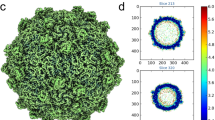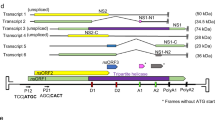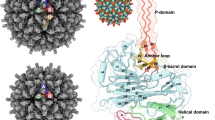Abstract
Arc, a neuronal gene that is critical for synaptic plasticity, originated through the domestication of retrotransposon Gag genes and mediates intercellular messenger RNA transfer. We report high-resolution structures of retrovirus-like capsids formed by Drosophila dArc1 and dArc2 that have surface spikes and putative internal RNA-binding domains. These data demonstrate that virus-like capsid-forming properties of Arc are evolutionarily conserved and provide a structural basis for understanding their function in intercellular communication.
This is a preview of subscription content, access via your institution
Access options
Access Nature and 54 other Nature Portfolio journals
Get Nature+, our best-value online-access subscription
$29.99 / 30 days
cancel any time
Subscribe to this journal
Receive 12 print issues and online access
$209.00 per year
only $17.42 per issue
Buy this article
- Purchase on Springer Link
- Instant access to full article PDF
Prices may be subject to local taxes which are calculated during checkout



Similar content being viewed by others
Data availability
Atomic coordinates have been deposited in PDB under the following accession numbers: 6TAP, 6TAQ, 6TAR, 6TAS, 6TAT and 6TAU. Cryo-electron microscopy density maps have been deposited in the Electron Microscopy Data Bank under the following accession numbers: EMD-10423, EMD-10424, EMD-10425, EMD-10426, EMD-10427 and EMD-10428. Requests for raw data or materials should be addressed to jbriggs@mrc-lmb.cam.ac.uk.
References
Shepherd, J. D. & Bear, M. F. Nat. Neurosci. 14, 279–284 (2011).
Plath, N. et al. Neuron 52, 437–444 (2006).
McCurry, C. L. et al. Nat. Neurosci. 13, 450–457 (2010).
Pastuzyn, E. D. et al. Cell 172, 275–288.e18 (2018).
Ashley, J. et al. Cell 172, 262–274.e11 (2018).
Mosher, J. et al. Dev. Biol. 405, 280–290 (2015).
Mattaliano, M. D., Montana, E. S., Parisky, K. M., Littleton, J. T. & Griffith, L. C. Mol. Cell. Neurosci. 36, 211–221 (2007).
Abrusán, G., Szilágyi, A., Zhang, Y. & Papp, B. Nucleic Acids Res. 41, 3190–3200 (2013).
Campillos, M., Doerks, T., Shah, P. K. & Bork, P. Trends Genet. 22, 585–589 (2006).
Huang, C. R. L., Burns, K. H. & Boeke, J. D. Annu. Rev. Genet. 46, 651–675 (2012).
Bourque, G. et al. Genome Biol. 19, 199–12 (2018).
Dodonova, S. O., Prinz, S., Bilanchone, V., Sandmeyer, S. & Briggs, J. A. G. Proc. Natl Acad. Sci. USA 116, 10048–10057 (2019).
Nielsen, L. D., Pedersen, C. P., Erlendsson, S. & Teilum, K. Structure 27, 1071–1081.e5 (2019).
Zhang, W. et al. Neuron 86, 490–500 (2015).
Zhang, W. et al. Mol. Cell 75, 13–25.e5 (2019).
Eriksen, M. S. et al. Preprint at bioRxiv https://www.biorxiv.org/content/10.1101/667956v1 (2019).
De Guzman, R. N. et al. Science 279, 384–388 (1998).
Amarasinghe, G. K. et al. J. Mol. Biol. 301, 491–511 (2000).
Mastronarde, D. N. Microsc. Microanal. 9, 1182–1183 (2003).
Zheng, S. Q. et al. Nat. Meth. 14, 331–332 (2017).
Rohou, A. & Grigorieff, N. J. Struct. Biol. 192, 216–221 (2015).
Zivanov, J. et al. eLife 7, e42166 (2018).
Scheres, S. H. W. J. Struct. Biol. 180, 519–530 (2012).
Zivanov, J., Nakane, T. & Scheres, S. H. W. IUCrJ 6, 5–17 (2019).
Rosenthal, P. B. & Henderson, R. J. Mol. Biol. 333, 721–745 (2003).
Kucukelbir, A., Sigworth, F. J. & Tagare, H. D. Nat. Meth. 11, 63–65 (2014).
Ramírez-Aportela, E. et al. Bioinformatics https://doi.org/10.1093/bioinformatics/btz671 (2019).
Webb, B. & Sali, A. Methods Mol. Biol. 1654, 39–54 (2017).
Emsley, P. & Cowtan, K. Acta Crystallogr. D Biol. Crystallogr. 60, 2126–2132 (2004).
Adams, P. D. et al. Acta Crystallogr. D Biol. Crystallogr. 66, 213–221 (2010).
Afonine, P. V. et al. Acta Crystallogr. D Struct. Biol. 74, 531–544 (2018).
Pettersen, E. F. et al. J. Comput. Chem. 25, 1605–1612 (2004).
Touw, W. G., van Beusekom, B., Evers, J. M. G., Vriend, G. & Joosten, R. P. Acta Crystallogr. D Struct. Biol. 72, 1110–1118 (2016).
Williams, C. J. et al. Protein Sci. 27, 293–315 (2018).
Notredame, C., Higgins, D. G. & Heringa, J. J. Mol. Biol. 302, 205–217 (2000).
Robert, X. & Gouet, P. Nucleic Acids Res. 42, W320–W324 (2014).
Edgar, R. C. BMC Bioinf. 5, 113–119 (2004).
Li, T. et al. Curr. HIV Res. 15, 31–37 (2017).
Kumar, S., Stecher, G. & Tamura, K. Mol. Biol. Evol. 33, 1870–1874 (2016).
Acknowledgements
We thank S. Scheres, T. Nakane and G. Murshudov (Medical Research Council Laboratory of Molecular Biology (MRC-LMB)) for advice on data processing and analysis, and J. Grimmett and T. Darling (MRC-LMB) for support with computing infrastructure. This study was supported by the MRC-LMB Electron Microscopy Facility. This work was funded by the Novo Nordisk Foundation (NNF17OC0030788 to S.E.), the National Institute of General Medical Sciences (R35-GM122550 to C.F.), the National Institute of Mental Health (R01-MH112766 to J.D.S.), the Chan Zuckerberg Initiative (to J.D.S) and the MRC (MC_UP_1201/16 to J.A.G.B.).
Author information
Authors and Affiliations
Contributions
S.E., J.D.S. and J.A.G.B. designed the project. S.E. prepared all samples and performed cryo-electron microscopy sample preparation and screening, reconstruction and model building with assistance from D.R.M. and J.A.G.B. H.B.C. and C.F. designed and performed evolutionary sequence analyses. S.E., J.D.S. and J.A.G.B. prepared the manuscript. All authors commented on the final manuscript.
Corresponding author
Ethics declarations
Competing interests
J.D.S. is a paid consultant for a company exploring the biotechnological applications of domesticated retrotransposons. All other authors declare no competing interests.
Additional information
Publisher’s note Springer Nature remains neutral with regard to jurisdictional claims in published maps and institutional affiliations.
Extended data
Extended Data Fig. 1 Full capsid atomic model of the dArc2.
The views and color scheme are similar to those shown in Fig. 2. a, The 12 five-fold capsomeres are coloured in green (CANTD), and yellow (CACTD). The 30 two-fold capsomeres are coloured in cyan to blue (CANTD) and orange to red (CACTD). b, The asymmetric unit containing four CA molecules. 60 asymmetric units including 240 individual CA molecules make up the T=4 capsid. c, Close-up of the five-fold capsomere (outlined in a) i) Cut-away showing three out of five N-termini in the centre of the capsomeres. The N-termini extend into and form the capsid spikes. The N-termini are stabilized by docking into an extended hydrophobic groove adjacent to α1. d, External view of the five-fold capsomere i) The CANTD:CANTD interaction between α1, and α2 and α3 of the neighbouring CA molecule in the capsomere. Electronegative charged residues on the outside of α1 interact with electropositive charges in α2 and α3. ii) The CANTD:CACTD interface which involves α6 in the CACTD and α3 and α4 in the neighbouring CANTD. This interface relies on both hydrophobic and electrostatic interactions. Residues R43, I80, W84, F106, C135 and D131 are depicted in the figure. e, External view of the two and three-fold CACTD interfaces. i) The two-fold CACTD interface connects two adjacent capsomeres and is dominated by hydrophobic π-stacking interactions. The interface involves residues from α5 and α. Residues Y113, Y116, F120, R148, T153, F157 and Y159 are depicted in figure. EM density is shown only for the contact site. All CACTD interfaces are highly similar (Supplementary Fig. 7). ii) The three-fold CACTD axis. At this position, instead of the histidine present in dArc1, E168 and S169 from α8 surround the largest gap in the capsid. The corresponding views for dArc1 are shown in Fig. 2.
Extended Data Fig. 2 Sequence alignment of dArc1 and dArc2, rArc and Ty3.
a, Domain overview. Matrix-like domain (MA; Green), capsid domain (CA; blue), nucleocapsid domain (NC; red). Only rArc contains a putative MA domain but lacks the NC domain. dArc2 is shortest of the four and only codes for the CA domain. b, The amino acid sequence alignment shows good overall alignment of the CA coding region for all proteins. Conserved residues are Brown, Equivalent residues (T-Coffee equivalence score >0.7) are grey. c, The amino acid sequence alignment between dArc1 and dArc2. Except for the Poly-alanine stretch and the NC domain, the sequences are highly conserved. The zinc finger region is marked.
Extended Data Fig. 3 Comparison of dArc1 and dArc2 capsomer structures.
a, Comparison of five-fold symmetric capsomeres of dArc1 (colored) and dArc2 (grey). Full model Cα-RMSD: 0.7 Å. b, Comparison of two-fold symmetric capsomeres of dArc1 (colored) and dArc2 (grey). Full model Cα-RMSD: 0.9 Å.
Extended Data Fig. 4 Alignment of the dArc1 and rat Arc structures.
a-b, The dArc1 CA structure from the five-fold capsomere, compared to the full-length rat Arc (rArc) CA structure (obtained by Nuclear Magnetic Resonance, PDB ID: 6GSE)13. The rArc CANTD and CACTD are depicted in grey and light grey, respectively. The individual CANTD and CACTD folds are completely conserved. The flexible linker connecting CANTD and CACTD in the dArc CA capsid structure is more rigid in the monomeric rArc and the interdomain orientation is different. c, Alignment between dArc1 CANTD (green) and the rArc CANTD (grey) crystal structure (PDB ID: 4X3H)14 bound to the transmembrane AMPAR regulatory protein γ2 (TARPγ2) (pink). The binding site for TARPγ2, CaMKII and NMDA peptides in rArc, is occupied by the N-terminus in dArc1 and dArc2.
Extended Data Fig. 5 Flexibility of the CA domain within the dArc1 capsid.
a, Overview of the atomic structure of the dArc1 capsid with one five-fold and one two-fold capsomere highlighted. b-c, Top and side views of the five-fold and two-fold capsomeres to indicate the color coding in the following panels. d, The four different conformations of CA in the asymmetric unit aligned by either the CANTD or the CACTD domain. e, Flexibility of the four different CANTD:CANTD interfaces in the capsomeres, with the central CANTD aligned. For the adjacent CANTD Cα-RMSD: 8.6 Å. The interface accommodates relative displacements up to 55° between α1 and α2-3 in the adjacent CANTD. f, Flexibility of the four different CANTD:CACTD interfaces, with the CACTD aligned. There are only subtle movements of the neighboring residues in the CANTD relative to the CACTD. For CANTD residues involved in the interface (97-103, 117-119, 53-58), Cα-RMSD: 4.8 Å. For the full adjacent CANTD, Cα-RMSD: 6.9 Å. g, The two different conformations of the CACTD:CACTD interface. The CACTD domains forming the interfaces between adjacent capsomeres are less variable than the interfaces created between CANTD:CACTD and CANTD:CANTD shown above. Cα-RMSD for the two CTD domains forming the dimeric interface: 0.4 Å. h, Alignment of the three-fold CACTD and pseudo-three-fold CACTD axes. The histidines are positioned 6 Å apart in the true three-fold and 6 or 10 Å apart in the pseudo three-fold axes.
Extended Data Fig. 6 Alignment of the dArc1 and mature HIV-1 structures.
a, CA from the five-fold capsomere of the dArc1 capsid aligned with CA from the HIV-1 CA pentamer from mature virions (PDB ID: 5MCY) 5by either CANTD (HIV-1; light blue) or CACTD (HIV-1; dark blue). The HIV-1 CANTD is composed by 7 helical segments and an N-terminal β-Hairpin. α1-α4 in dArc CANTD correspond to α2-α4 and α7 in the HIV-1 CANTD. The CACTD fold is well conserved. b-c, The arrangement of CACTD at the two and three-fold interfaces in the dArc capsid is similar to the arrangement at the corresponding positions in mature HIV-1 (PDB ID: 5MCX)40. The HIV-1 two-fold CACTD interface is constituted by a short 310 helical segment and α9 which align with dArc α5 and α7, respectively. Mutations in HIV-1 CA α9 are known to disrupt virus assembly and maturation41 40. Mattei, S., Glass, B., Hagen, W. J. H., Kräusslich, H.-G. & Briggs, J. A. G. The structure and flexibility of conical HIV-1 capsids determined within intact virions. Science 354, 1434–1437 (2016). 41. Joshi, A., Nagashima, K. & Freed, E. O. Mutation of dileucine-like motifs in the human immunodeficiency virus type 1 capsid disrupts virus assembly, gag-gag interactions, gag-membrane binding, and virion maturation. J. Virol. 80, 7939–7951 (2006).
Extended Data Fig. 7 Alignment of the dArc1 and Ty3 structures.
a, CA from the five-fold capsomere of the dArc1 capsid aligned with CA from the five-fold capsomere of Ty3, either aligned on CANTD (Ty3; dark grey) or CACTD (Ty3; light grey). The structures of CANTD and the CACTD domains are very similar but differ in the inter-domain orientation. b-c, The arrangement of CACTD at the two and three-fold dArc interfaces is very similar to the arrangement at the corresponding positions in Ty3. d, The two-fold CACTD:CACTD contact surfaces for dArc1 and dArc2 are facilitated by hydrophobic stacking interactions, primarily between α5 and α7. The Ty3 interface also involves hydrophobic residues in α5 and α7, but lacks direct α5 - α5 contacts. e, The Ty3 three-fold CACTD interface also contains a three-fold symmetric histidine cluster (H170) positioned at the outer edge of the pore. f, Comparison of dArc1 (green) and the Ty3 (grey) CANTD:CANTD interfaces from pentameric capsomeres aligned by the central CANTD. g, Comparison of dArc1 (shades of blue) and the Ty3 (shades of grey) CANTD:CANTD interfaces from hexameric capsomeres aligned by the central CANTD.
Extended Data Fig. 8 Purifying selection is acting on all dArc1 and dArc2 domains.
The diagram shows dN:dS values computed using PAML (see Methods) for each of the structural domains of dArc1 and dArc2. A dN:dS ratio less than 1 is indicative of purifying selection. A Chi-Square Likelihood Ratio Test was used to compare the likelihood value of the calculated dN:dS to the likelihood that the sequence is under neutral evolution. All dN:dS values on dArc1 (n = 32 species) and dArc2 (n = 33 species) show statistically significant (P<0.0001) purifying selection compared with a neutral evolution model.
Extended Data Fig. 9 Electrostatic potential of individual capsomeres of dArc1 and dArc2.
a, As in Fig. 3, the surface is coloured with the electrostatic potential from -5 (red) to +5 kbT/e (blue). The dArc2 capsomeres are more electropositive than the dArc1 capsomeres. b, Close-ups showing that additional neutral-to-basic residue substitutions facilitate electrostatic charge differences in the capsid interior.
Supplementary information
Supplementary Information
Supplementary Figures 1–5 and Supplementary Tables 1–2.
Supplementary Video 1
Surface representation of the unsharpened dArc1 capsid reconstruction colored by radius as in Fig. 1b–c.
Supplementary Video 2
Surface representation of the unsharpened dArc2 capsid reconstruction colored by radius as in Fig. 1e–f.
Supplementary Video 3
Tour of the dArc1 capsid electron density map and atomic model.
Supplementary Video 4
Tour of the atomic model of the dArc1 zinc finger region illustrating how it is coordinated beneath the two-fold capsomeres.
Supplementary Data 1–4
Supplementary Data.
Rights and permissions
About this article
Cite this article
Erlendsson, S., Morado, D.R., Cullen, H.B. et al. Structures of virus-like capsids formed by the Drosophila neuronal Arc proteins. Nat Neurosci 23, 172–175 (2020). https://doi.org/10.1038/s41593-019-0569-y
Received:
Accepted:
Published:
Issue Date:
DOI: https://doi.org/10.1038/s41593-019-0569-y
This article is cited by
-
Recurrent co-domestication of PIF/Harbinger transposable element proteins in insects
Mobile DNA (2022)
-
A novel serum spherical lectin from lamprey reveals a more efficient mechanism of immune initiation and regulation in jawless vertebrates
Cellular & Molecular Biology Letters (2022)
-
Arc weakens synapses by dispersing AMPA receptors from postsynaptic density via modulating PSD phase separation
Cell Research (2022)
-
Structure of a Ty1 restriction factor reveals the molecular basis of transposition copy number control
Nature Communications (2021)
-
Structure of an Arc-ane virus-like capsid
Nature Neuroscience (2020)



